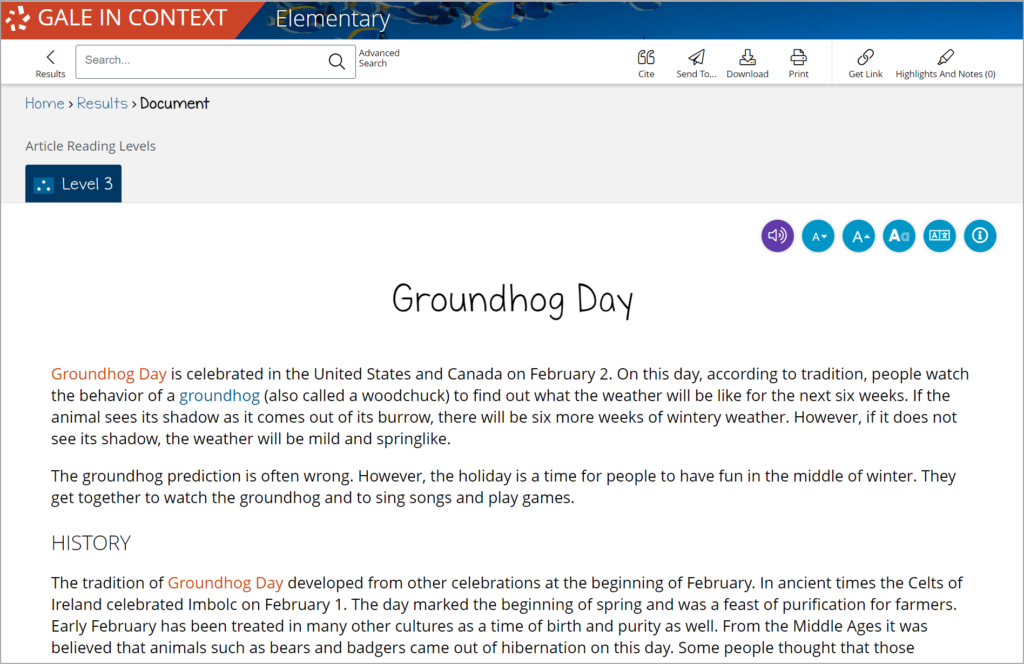Create Fun Activities for This Quirky American Holiday
| By Gale Staff |
Your young learners may not know what a groundhog is, let alone why we have a day to celebrate it each year. They might not understand why thousands of people gather in Punxsutawney, Pennsylvania, on a cold morning every February to watch a man in a tuxedo hold a groundhog—while many more watch the ceremony live on television.
Why not take advantage of this eccentric holiday to both teach your students about Groundhog Day traditions and develop their research skills? Help your young thinkers begin developing digital literacy in a safe, engaging online environment with Gale In Context: Elementary.
Discover the History of Groundhog Day
Groundhog Day is celebrated on February 2 each year. It was originally intended to acknowledge the beginning of spring. In Medieval Times, many people believed the beginning of February marked the end of the hibernation season for those animals that slept through the winter months. Some even believed that those same animals could foretell the weather. When those cultures immigrated to the United States, they adapted those superstitious traditions for a more regionally appropriate critter: the groundhog.

Now, each February 2, Americans can tune in to live coverage of Punxsutawney Phil, a Pennsylvania groundhog (and minor celebrity), as he’s brought out of hibernation. For a fun classroom activity, you can stream the coverage of Punxsutawney Phil for your class. Legend dictates if Phil sees his shadow and turns back into his den out of fright, there will be six more weeks of winter weather. If he remains above ground, spring is predicted to be around the corner. Unfortunately, Phil is only right about 39% of the time.
In anticipation of this fun day, encourage your students to search “Groundhog Day” in the Gale In Context: Elementary collection to discover dozens of age-appropriate resources, including book and magazine articles, pictures, and news entries.
Activity Idea: Before tuning into the live coverage, ask your students to vote on what they think Phil will do this year. For extra engagement, have students look into the year they were born—did Phil see his shadow that year? Was the prediction correct?
Explore the Habits of an Actual Groundhog
Ask your students if they’ve ever seen a groundhog before. Have those who have seen a groundhog describe it to their peers. Consider creating a science-based lesson and guiding your students toward some basic animal research. Gale In Context: Elementary has extensive pictures and information to help students learn more about groundhogs and other animals that hibernate. Physical descriptions, habits, diet, and territory are outlined via clear sentences with a simple vocabulary suitable for their reading levels.

Activity Idea: Ask each student to select an animal that hibernates and complete a short research project. Have them answer why their chosen animal hibernates during the winter and how it prepares for the hibernation period.
Create Memorable Lesson Plans
Elementary teachers and children’s librarians can use Gale In Context: Elementary to find creative and sometimes silly activities to celebrate Groundhog Day. You might assign students a simple quiz and encourage them to find the answers in Elementary. For younger learners, discover songs and fun poems to practice reading together.
Find ready-made lesson-plan outlines with built-in discussion questions and supplemental resources. You can always add your own flair and customizations for your specific group of children, but why not search for a little inspiration first?
Leverage Accessibility Tools for Young Learners
Gale In Context: Elementary is customized to help younger children practice their research skills. It is structured in an approachable, colorful format designed to keep students engaged. Elementary categorizes information with bright visual aids, so students can easily navigate these collections. Plus, all of Gale’s resources are built with accessibility and varying learning styles in mind. Teachers and librarians can help students navigate to display and audio features to better support their learning. And by integrating Gale products into your classroom activities, you can help students practice with EdTech tools early, making them better prepared for future learning and research.
Interested in learning more? Request a demo or a trial of Gale In Context: Elementary for your classroom or library.

